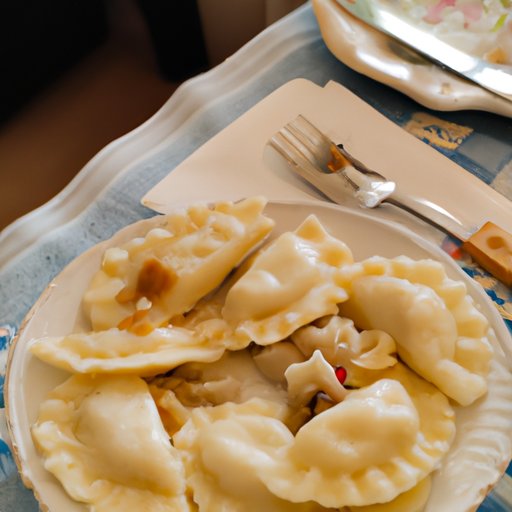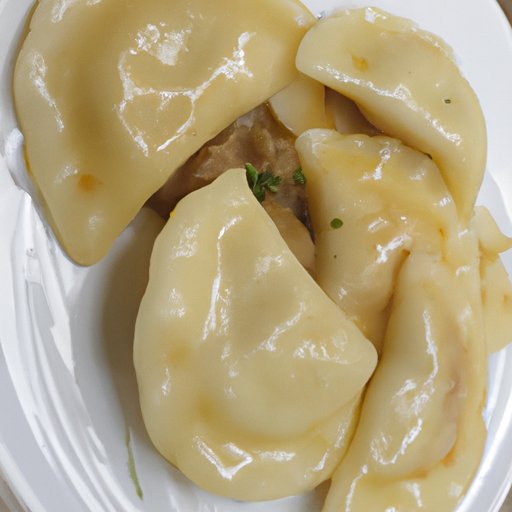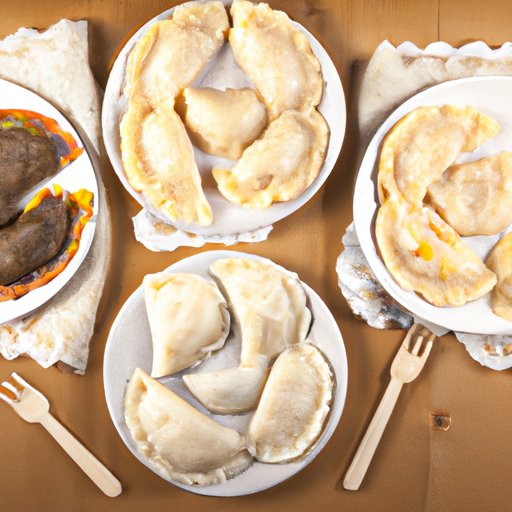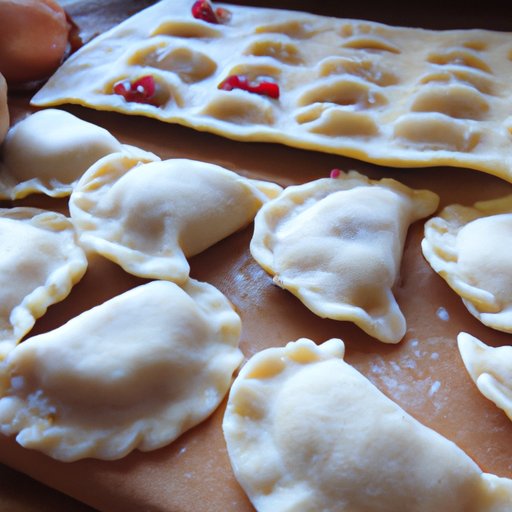Introduction
Perogies are a delicious type of dumpling that is popular in many countries around the world. They are made from dough that is stuffed with various fillings such as potatoes, cheese, meat, vegetables, or fruit, then boiled or fried. Perogies can be enjoyed as a main dish, side dish, or snack and are incredibly versatile, making them a great addition to any meal.
Create a Step-by-Step Guide to Preparing and Eating Perogies
Making perogies at home is simple, and there are two basic methods for preparing them: boiling and frying. Here’s a step-by-step guide for both methods.
Boiling the Perogies
1. Bring a large pot of salted water to a boil over high heat.
2. Carefully add the perogies to the boiling water.
3. Boil the perogies for 3-5 minutes, stirring occasionally.
4. When the perogies are cooked through, drain them in a colander.
Frying the Perogies
1. Heat a large skillet over medium-high heat.
2. Add a tablespoon of oil or butter to the pan.
3. Place the perogies in the hot skillet and fry for 3-5 minutes, flipping once halfway through.
4. Once the perogies are golden brown, remove them from the pan and serve.
Serving Suggestions
Perogies can be served in a variety of ways. For a classic presentation, try serving them with a dollop of sour cream and a sprinkle of chives or bacon bits. You can also top them with sautéed mushrooms, caramelized onions, or your favorite sauce. For a heartier meal, serve the perogies with a side of roasted vegetables or a green salad.

Share Delicious Recipes for Different Types of Perogies
The possibilities for perogy fillings are endless, so let your imagination run wild! Here are a few delicious recipes to get you started.
Traditional Potato and Cheese Perogies
Ingredients:
- 2 cups mashed potatoes
- ½ cup shredded cheddar cheese
- ¼ cup chopped chives
- 1 teaspoon garlic powder
- 1 teaspoon onion powder
- Salt and pepper, to taste
- 2 cups all-purpose flour
- 1 egg, beaten
- ¼ cup water, or as needed
Instructions:
- In a bowl, mix together the mashed potatoes, cheese, chives, garlic powder, onion powder, salt, and pepper.
- In a separate bowl, whisk together the flour, egg, and water until a soft dough forms.
- Roll out the dough on a lightly floured surface to 1/8-inch thick. Cut circles with a biscuit cutter or drinking glass.
- Place a spoonful of filling in the center of each circle. Fold the circles in half and press the edges together to seal.
- Boil or fry the perogies according to the instructions above.
Savory Meat-Filled Perogies
Ingredients:
- 1 pound ground beef
- 1 small onion, diced
- 2 cloves garlic, minced
- 1 teaspoon paprika
- 1 teaspoon dried oregano
- 1 teaspoon dried thyme
- Salt and pepper, to taste
- 2 cups all-purpose flour
- 1 egg, beaten
- ¼ cup water, or as needed
Instructions:
- In a skillet over medium-high heat, cook the ground beef, onion, and garlic until the beef is no longer pink and the onion is tender.
- Stir in the paprika, oregano, thyme, salt, and pepper and set aside to cool.
- In a separate bowl, whisk together the flour, egg, and water until a soft dough forms.
- Roll out the dough on a lightly floured surface to 1/8-inch thick. Cut circles with a biscuit cutter or drinking glass.
- Place a spoonful of filling in the center of each circle. Fold the circles in half and press the edges together to seal.
- Boil or fry the perogies according to the instructions above.
Sweet Berry or Fruit-Filled Perogies
Ingredients:
- 2 cups fresh or frozen berries or fruit of your choice
- 2 tablespoons sugar
- 2 tablespoons cornstarch
- 1 teaspoon lemon juice
- 2 cups all-purpose flour
- 1 egg, beaten
- ¼ cup water, or as needed
Instructions:
- In a saucepan over medium heat, combine the berries or fruit, sugar, cornstarch, and lemon juice. Cook, stirring occasionally, until the mixture has thickened, about 5 minutes.
- Remove from the heat and set aside to cool.
- In a separate bowl, whisk together the flour, egg, and water until a soft dough forms.
- Roll out the dough on a lightly floured surface to 1/8-inch thick. Cut circles with a biscuit cutter or drinking glass.
- Place a spoonful of filling in the center of each circle. Fold the circles in half and press the edges together to seal.
- Boil or fry the perogies according to the instructions above.
Offer Tips for Making the Perfect Perogy
Once you have perfected the art of making perogies, here are a few tips to ensure they turn out perfectly every time.
Use Quality Ingredients
Using quality ingredients is key to making great-tasting perogies. Choose potatoes that are firm and free of blemishes, and opt for good-quality cheeses and meats. For the dough, use a high-quality all-purpose flour for the best results.
Don’t Overstuff the Dough
It may be tempting to stuff the perogies with as much filling as possible, but doing so will make it difficult to seal the edges properly. To avoid this, use about a tablespoon of filling per perogy.
Boil Gently
When boiling the perogies, make sure to do so gently. Boiling them too vigorously can cause them to break apart, so keep the heat low and stir them gently.

Discuss the Health Benefits of Eating Perogies
Perogies are not only delicious, but they are also quite nutritious. Here are a few health benefits associated with eating perogies.
Nutritional Content
Perogies are a good source of protein, carbohydrates, and vitamins and minerals such as iron, calcium, and vitamin B6. Depending on the type of filling used, they can also provide a good amount of dietary fiber.
Low Calorie Count
Perogies are relatively low in calories, making them a great option for those who are watching their weight. One small perogy contains about 40 calories, so you can enjoy them without feeling guilty.
Gluten-Free Options
For those who need to follow a gluten-free diet, there are plenty of options available. Look for gluten-free perogies made with rice, buckwheat, or other gluten-free flours.

Compare Regional Varieties of Perogies
Perogies have been enjoyed for centuries, and there are many different regional variations. Here are a few of the most popular types of perogies.
Polish Pierogi
Pierogi are the most popular type of perogies in Poland, where they are traditionally filled with potatoes, cheese, and sauerkraut. They are usually boiled and served with a dollop of sour cream.
Ukrainian Varenyky
Varenyky, or Ukrainian dumplings, are similar to pierogi but are typically filled with potatoes and cheese, mushrooms, cabbage, or sweet fruits and berries. They can be boiled or fried and often served with melted butter and a sprinkling of fried onions.
Belarusian Pyachysta
Pyachysta are Belarusian dumplings that are usually filled with potatoes, cabbage, mushrooms, or cheese. They are boiled and served with melted butter and a dollop of sour cream.
Conclusion
Perogies are a delicious and versatile food that can be enjoyed as a main dish, side dish, or snack. Whether you choose to fill them with potatoes, cheese, meat, vegetables, or fruit, learning how to make and eat perogies is easy. With the right ingredients and techniques, you can create delicious perogies that everyone will love. Plus, you can take advantage of their nutritional benefits, making them a healthy addition to any meal.
Summary of the Article
This article explored how to eat perogies, including creating a step-by-step guide to preparing and eating them, sharing delicious recipes for different types of perogies, offering tips for making the perfect perogy, discussing the health benefits of eating perogies, and comparing regional varieties of perogies.
Final Thoughts
Perogies are an incredibly tasty and versatile food that can be enjoyed in many different ways. With a little practice, anyone can become an expert in making and eating perogies.
(Note: Is this article not meeting your expectations? Do you have knowledge or insights to share? Unlock new opportunities and expand your reach by joining our authors team. Click Registration to join us and share your expertise with our readers.)
